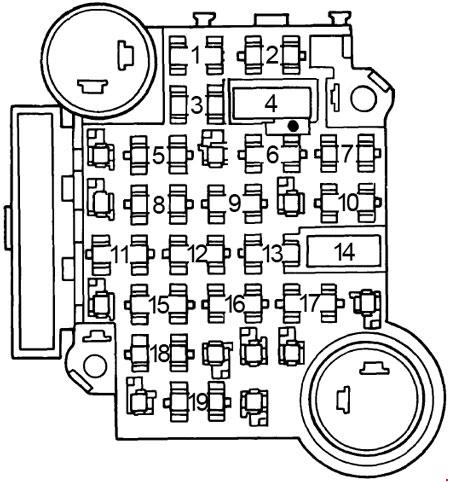Chevrolet El Camino 1978-1981 fuse box and relay Diagrams

The Chevrolet El Camino (1978-1981) is a unique vehicle that blends the design of a car and a pickup truck. Its electrical system is fairly straightforward, but it still relies on a fuse box and relays to manage and protect essential circuits.
The fuse box in the El Camino is typically located under the dashboard on the driver’s side. It protects electrical components like the headlights, tail lights, radio, and windshield wipers. Each fuse safeguards its respective system by breaking the circuit if there is an overload, preventing damage to the electrical components.
Relays in the El Camino are used to control high-current devices such as the horn, starter motor, and sometimes auxiliary lights. Relays allow low-power switches to control these high-power components, improving safety and efficiency. Routine inspection and replacement of blown fuses or faulty relays is necessary to maintain the vehicle’s electrical integrity, ensuring that everything from the lighting system to the starter functions correctly.
MUST READ: DYI – How to Check Car Fuses?
(1978-1981) Chevrolet El Camino fuse box and relay with Diagram
WARNING
- Never replace a fuse with one that has a higher amperage rating.
- A fuse with a too-high amperage could damage the electrical part and cause a fire.
- On no account should fuses be repaired (e.g. patched up with tin foil or wire) as this may cause serious damage elsewhere in the electrical circuit or cause a fire.
- If a fuse blows repeatedly, do not keep replacing it. Instead, have the cause for the repeated short circuit or overload tracked and fixed.
- Terminal and harness assignments for individual connectors will vary depending on vehicle equipment level, model, and market.
Chevrolet El Camino 1978-1981 fuse assignment
Year of production: from 1978, 1979, 1980, 1981
Fuse Box diagram

| No. | A | Circuit Protected |
| 1 | 5 | Instrument panel lights, alarm buzzer, heater dial light |
| 2 | 20 | Choke heater |
| 3 | 5 | Instrument panel lights, heater dial light |
| 4 | 30 | Circuit breaker: Power windows and sunroof |
| 5 | – | – |
| 6 | 25 | Heater and air conditioning |
| 7 | 10 | Electronic Control Module |
| 8 | – | – |
| 9 | 25 | Windshield wipers |
| 10 | 20 | Stop, hazard, courtesy, dome, glove box and engine compartment light |
| 11 | 10 | Cruise control, rear window defogger, gauges, closed loop, warning lamps and buzzers and tailgate unlock. |
| 12 | 20 | Parking, side marker, license and tail lights |
| 13 | 10 | Radio, idle stop solenoid, delay wipers |
| 14 | 30 | Circuit breaker: Power door locks, power seats, rear window defogger and tailgate lock |
| 15 | 20 | Back-up and turn signal lights |
| 16 | 20 | Luggage compartment light, cigar lighter, clock, courtesy lights, key warning buzzer, closed loop, dome and reading lights |
| 17 | – | – |
| 18 | – | – |
| 19 | – | – |
| Circuit Breaker:Headlights — Circuit breaker is integral with headlight switch to protect headlight circuit. Windshield Wiper — Circuit breaker integral with windshield wiper switch to protect wiper circuit. Power Seats, Power Windows & Power Door Locks — Circuit breaker is located on fuse panel to protect power accessories. Rear Window Defogger – Circuit breaker is located on fuse panel to protect rear window circuit. |
||
Conclusion
For owners and enthusiasts of classic Chevrolet El Camino 1978-1981, understanding the fuse box and relay systems is essential for vehicle maintenance. Regular inspection and maintenance of these components helped ensure the vehicle’s longevity and reliability, preserving its status as a symbol of Chevrolet’s craftsmanship and innovation in the automotive industry during that era.